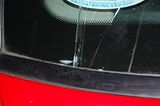Windsheild cracked overnight in the garage
#1
Windsheild cracked overnight in the garage
Not sure how it happened, it has been hot/humid. I have been running the air, also traveled 500 miles of the holiday weekend.
Given the placement of the cracks, it doesn't appear o be from external damage. It looks and feels like the dash pushed against it. The dash has never been out of this truck. So im at a loss.
Anyone have an opinion?




Given the placement of the cracks, it doesn't appear o be from external damage. It looks and feels like the dash pushed against it. The dash has never been out of this truck. So im at a loss.
Anyone have an opinion?




#2
#4
Garage was hot maybe around 85 with a dew point around 73, the window may have been pretty cold. I drove about 20 minutes with max ac on. I had the eatc set to maybe 65.
My ac will kick out around freezing, and the defroster does leak some air. I will get condensation on all windows and on very humid nights will need to run the wipers. Like last night.
Have had this truck since new in 99 and always run the ac when its nasty outside. Although I have just moved to new to me house with a garage I can actually use.
Im hoping this is just a random incident not any damage under the glass from rust or something.
My ac will kick out around freezing, and the defroster does leak some air. I will get condensation on all windows and on very humid nights will need to run the wipers. Like last night.
Have had this truck since new in 99 and always run the ac when its nasty outside. Although I have just moved to new to me house with a garage I can actually use.
Im hoping this is just a random incident not any damage under the glass from rust or something.
#9
Actually yes and no, glass is an amorphous solid
Find an old house with original windows, the bottom of the glass is thicker than the top, that's because over time the glass with slowly flow downward.
Look it up
Find an old house with original windows, the bottom of the glass is thicker than the top, that's because over time the glass with slowly flow downward.
Look it up
#11
#12
#13
At the bottom edge of the window the glass is pushed outward. There is no chip. Just the crack on the outside and 2 inside.

(click on the thumbnail for a large pic it is huge)
This is the best shot I got of the damage. What you see is under the glass. So i have my concerns about rust in the channel or glass that just failed from delamination.

(click on the thumbnail for a large pic it is huge)
This is the best shot I got of the damage. What you see is under the glass. So i have my concerns about rust in the channel or glass that just failed from delamination.
#14
No, that is due to poor manufacturing processes in the past. Show me one credible source that sites science backing up that old wives tale.
#15

Last edited by buckgnarly; 07-08-2010 at 10:01 PM.
#16
Modern glass is made differently, that's why it's not an issue.
Just because you're ignorant doesn't mean it isn't true. Go read a book
Or hell just google it
#18
Hell, I taught middle school and I know that is simply not true....like I said, post up a good (not Wikki or google crap) source and I am willing to learn something new. Until then, do not pass on wive's tales.....
#19
Are you arguing that glass is not an amorphous solid?
Encyclopedia Britannica defines an amorphous solid as: "any noncrystalline solid in which the atoms and molecules are not organized in a definite lattice pattern. Such solids include glass, plastic, and gel."
noncrystalline solids do flow under certain temperature ranges or external forces
Encyclopedia Britannica defines an amorphous solid as: "any noncrystalline solid in which the atoms and molecules are not organized in a definite lattice pattern. Such solids include glass, plastic, and gel."
noncrystalline solids do flow under certain temperature ranges or external forces
#20
Are you arguing that glass is not an amorphous solid?
Encyclopedia Britannica defines an amorphous solid as: "any noncrystalline solid in which the atoms and molecules are not organized in a definite lattice pattern. Such solids include glass, plastic, and gel."
noncrystalline solids do flow under certain temperature ranges or external forces
Encyclopedia Britannica defines an amorphous solid as: "any noncrystalline solid in which the atoms and molecules are not organized in a definite lattice pattern. Such solids include glass, plastic, and gel."
noncrystalline solids do flow under certain temperature ranges or external forces
The "flowing" of glass causing old windows to be thicker at the bottom...that's not true.
#21
No not all antique windows being thicker at the bottom are caused by flow, some are just not evenly thick.
But, it is possible under the right circumstances (mainly hot temperatures) to cause the glass to shift its structure, this has been proven in lab testing.
You are right to say they're not all caused by it, but some have been.
#22
#23
But look at the time, temp, and glass types that make up windows and you will see that they are #1 not old enough (nothing man made really is), #2 not at the right temps, and #3 not made of the right stuff.
#24
#25
If you've ever been to an old church or farm house from the early 1900's with original glass, check it out.







 Glass is a solid, not liquid....and no, it does not flow over time.
Glass is a solid, not liquid....and no, it does not flow over time.





